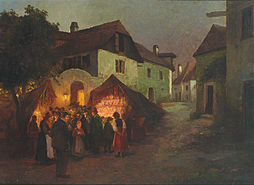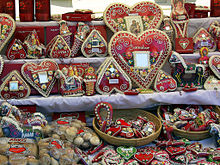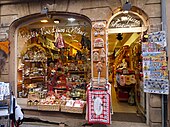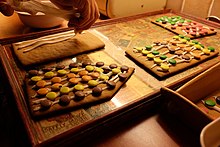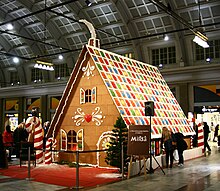
A cookie or biscuit is a baked snack or dessert that is typically small, flat, and sweet. It usually contains flour, sugar, egg, and some type of oil, fat, or butter. It may include other ingredients such as raisins, oats, chocolate chips, or nuts.

A biscuit, in most English speaking countries, is a flour-based baked and shaped food item. Biscuits are typically hard, flat, and unleavened. They are usually sweet and may be made with sugar, chocolate, icing, jam, ginger, or cinnamon. They can also be savoury, similar to crackers. Types of biscuit include sandwich biscuits, digestive biscuits, ginger biscuits, shortbread biscuits, chocolate chip cookies, chocolate-coated marshmallow treats, Anzac biscuits, biscotti, and speculaas.

Lebkuchen, Honigkuchen or Pfefferkuchen are honey-sweetened German cakes, moulded cookies or bar cookies that have become part of Germany's Christmas traditions. They are similar to gingerbread.

Fruitcake or fruit cake is a cake made with candied or dried fruit, nuts, and spices, and optionally soaked in spirits. In the United Kingdom, certain rich versions may be iced and decorated.

Gingerbread refers to a broad category of baked goods, typically flavored with ginger, cloves, nutmeg, and cinnamon and sweetened with honey, sugar, or molasses. Gingerbread foods vary, ranging from a moist loaf cake to forms nearly as crisp as a ginger snap.

The Striezelmarkt in Dresden is one of the first genuine Christmas markets in the world. Founded as a one-day market in 1434, it celebrated its 585th anniversary in 2019. Its 240 stands attract about 3 million visitors from all over the world. The annual market lasts throughout the Advent season until Christmas Eve.
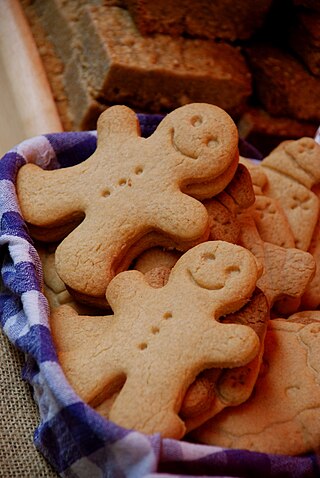
A gingerbread man is a biscuit or cookie made from gingerbread, usually in the shape of a stylized human being, although other shapes, especially seasonal themes and characters are common too.

Stollen is a fruit bread of nuts, spices, and dried or candied fruit, coated with powdered sugar or icing sugar and often containing marzipan. It is a traditional German Christmas bread. During the Christmas season the cake-like loaves are called Weihnachtsstollen or Christstollen.

A Christmas market is a street market associated with the celebration of Christmas during the four weeks of Advent. These markets originated in Germany, but are now held in many countries. Some in the U.S. have adapted the name to the quasi-German Christkindlmarket, substituting market for German Markt.

Kuchen, the German word for cake, is used in other languages as the name for several different types of savory or sweet desserts, pastries, and gateaux. Most Kuchen have eggs, flour and sugar as common ingredients while also, but not always, including some fat. In the Germanosphere it is a common tradition to invite friends over to one's house or to a cafe between noon and evening to drink coffee and eat Kuchen.

Christmas cookies or Christmas biscuits are traditionally sugar cookies or biscuits cut into various shapes related to Christmas.

Pfeffernüsse are small spice cookies, popular as a holiday treat with Germans and ethnic Mennonites in North America. Similar cookies are made in Denmark, and The Netherlands, as well. They are called Pfeffernüsse in German, pepernoten in Dutch, päpanät in Plautdietsch, pfeffernusse or peppernuts in English, and pebernødder in Danish.
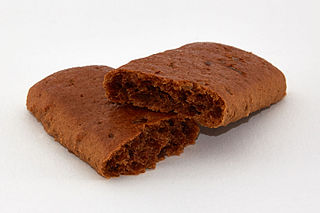
Aachener Printen are a type of Lebkuchen originating from the city of Aachen in Germany. Somewhat similar to gingerbread, they were originally sweetened with honey, but are now generally sweetened with a syrup made from sugar beets.

Cookie decorating dates back to at least the 14th century when in Switzerland, springerle cookie molds were carved from wood and used to impress Biblical designs into cookies.

Berner Honiglebkuchen are Lebkuchen traditionally made in Bern, Switzerland. Distinguished from other Lebkuchen by their sometimes elaborate sugar decorations, they are not to be confused with the Berner Haselnusslebkuchen, another Bernese specialty which is made from ground hazelnuts.

Kerststol is a traditional Dutch oval-shaped fruited Christmas bread. The yeast-based bread contains dried fruits, raisins and currants, lemon and orange zest, water, milk, butter, sugar, vanilla and cinnamon. A more luxurious variety may include chopped walnuts, almonds, or hazelnuts. Ginger powder or grated crystallized ginger, dried cherries and cranberries, apple, kiwi or cardamom may also be added to this pastry dough.

Licitars are colorfully decorated biscuits made of sweet honey dough that are part of Croatia and Slovenia's cultural heritage. They are a traditional symbol of the Croatian capital Zagreb. They are used as an ornamental gift, often given at celebrations of love such as weddings and Valentine's Day.

Franconian cuisine is an umbrella term for all dishes with a specific regional identity belonging to the region of Franconia. It is a subtype of German cuisine with many similarities to Bavarian cuisine and Swabian cuisine. It is often included in the Bavarian cuisine, since most parts of Franconia belong to Bavaria today. There are several Franconian food items that are also famous beyond the borders of Franconia, such as Nürnberger Lebkuchen, Bratwurst and the wines of Franconia. Franconia is also famous for its beer and harbours the highest density of breweries in the world.
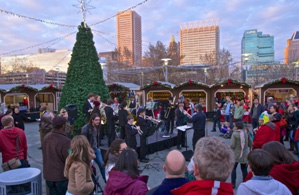
Christmas Village in Baltimore is an annual holiday market event in Baltimore's Inner Harbor, with vendors in both traditional wooden booths and a festival tent. Commercial vendors sell international seasonal holiday gifts, ornaments, arts and crafts, as well as European food, sweets and hot beverages.

